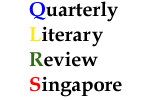 |
 |
|||||||||||||
|
By Toh Hsien Min The uncertainties of living out came up again over a casual dinner one Friday night. Rui, the Portuguese bloke who used to occupy the room I now do, came by for dinner with me and my housemate, as he was finally leaving Singapore for good. Among expats, as among New Yorkers, it’s probably not unusual for the topic of rental property to come up. Somehow it did, and Rui slipped in a casual, “As you know, this place is going to be demolished in two years’ time anyway.” What a shock! I had only been staying in one of the most extraordinary apartments in Singapore for half a year, and to hear that it wouldn’t be for very much longer... the thought was just too distressing. Even if, or maybe because, I hadn’t found the flat; the flat found me. Rui had posted an notice on a social email list to announce that he was returning to Portugal, therefore his half-share in a rented colonial walk-up in the Mount Sophia area was coming available. A month later, as I was due to visit my optician at Peace Centre, I thought it the easiest thing to just drop by and view the place, as much for a lark as anything else. Lives change in minutes. Mine broke from its trajectory when I saw the beautiful white façade, with the bold “1930” imprinted on the top. It could only have been a colonial apartment that could have had that effect on me; charm distils through age, but the colonial British architects also knew, perhaps better than our contemporary ones, how to build for the tropics. I noted the high ceilings that gave a sense of space and kept the apartment cool, old frosted glass windows set in beige-painted wood frames, and a collection of distinctively peninsular spiral staircases. Two huge bedrooms, one huge living room in a chinoiserie yellow, a functional kitchen, a balcony that lets light and air in, and a huge open rooftop completed the tour. I was hooked. Over the next months, I would discover complete other sides to Singapore. Selegie boasts an abundance of life. There are numerous good food places, such as the legendary Rochor Beancurd, a sushi bar that opens up to 4am on weekend nights, some 24-hour eating places, and plenty of choices for coffee (especially given my fussiness on that score). A traffic junction keeps everything in place. On the one side, there is the feel of a Chinese working-class area, with Chinese DVD shops, aquariums, Chinese coffeeshops, photocopying shops and a number of karaoke bars, spilling from Paradiz Centre onto Prinsep Street. A few hundred yards east, the flavour changes completely. Little India starts at the next junction east, and Indian temples, textile shops, grocers, curry houses and coffeeshops are numerous. On Sundays, Indian labourers throng the area, touching the walls at Tekka market. North of the same junction, the Sophia Road extends through to the back of the Istana, an enclave of expatriates living in a collection of colonial houses and modern condominiums. So it was partly good news to read in the Straits Times, earlier this month, that the URA are proposing to conserve the area, including the building I now live in. I may still have to move out, as the scheduled work is – as I subsequently found out – not demolition but a renovation, but it’s nice to know Singapore continues to retain a little bit of its heritage.
QLRS is built on a Singaporean base as well, but like any football team or tiny island-state, we occasionally need to import some foreign talent. This month the inflow has become a quite torrent. This could be partly because we seem to be gathering recognition overseas; only a week ago, a PhD candidate in a French university wrote to say she was citing material published here in her thesis. In any case, our poetry section contains a Palestinian, an Australian, a Hawaiian, a Hong Konger, an Indian and a continental American, alongside Singaporean writers. Our essays section showcases perspectives from India, France and Hong Kong. The interchange of ideas can also be seen in the reviews of the Singapore Arts Festival. If QLRS helps to plug Singapore writers into an international circuit, in however small a way, it will be worth the effort of all our editors. Speaking of festivals, Alvin Pang (whose long-awaited second collection is reviewed in this issue), Cyril Wong, Felix Cheong and myself are off to the Edinburgh International Book Festival in a matter of weeks. Along the way, we will also be reading at the Poetry Society in London, and meeting with a number of participants in Britain’s rich literary scene, from writers to critics to publishers. While collectively we hope to advance our literary ambassadorship in the best possible light, it’d also be a minor homecoming for me, as I spent some of the most splendid times of my life in patterned brick buildings on Parks Road and a terrace house on Walton Street. The Brits really know how to build ’em. How much of the past does the future need? Discuss in the Forum.
_____
|
|
|||||||||||||
Copyright © 2003 The Authors
Privacy Policy | Terms of Use |
E-mail